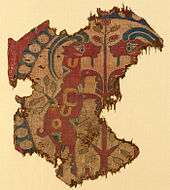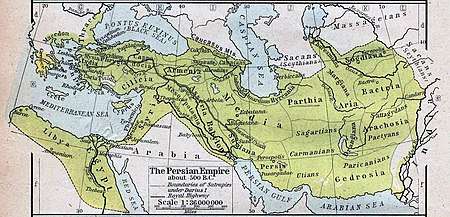Sogdia
Sogdia (/ˈsɒɡdiə/) (Sogdian: soɣd) or Sogdiana was an ancient Iranian civilization that at different times included territory located in present-day Uzbekistan, Tajikistan, Kazakhstan, and Kyrgyzstan, such as Samarkand, Bukhara, Khujand, Panjikent, and Shahrisabz. Sogdiana was also a province of the Achaemenid Empire, eighteenth in the list on the Behistun Inscription of Darius the Great (i. 16). In the Avesta, Sogdiana is listed as the second best land that the supreme deity Ahura Mazda had created.[4] It comes second, after Airyanem Vaejah, "homeland of the Aryans", in the Zoroastrian book of Vendidad, indicating the importance of this region from ancient times.[5][6] Sogdiana was first conquered by Cyrus the Great, the founder of the Achaemenid Empire. The region would then be annexed by the Macedonian ruler Alexander the Great in 328 BC. The region would continue to change hands under the Seleucid Empire, Greco-Bactrian Kingdom, Kushan Empire, Hephthalite Empire, and Sasanian Empire.
 Sogdiana, c. 300 BC, then under the Seleucid Empire, one of the successor states to the empire created by Alexander the Great | |
| Languages | Sogdian language |
|---|---|
| Religions | Zoroastrianism, Buddhism, Manichaeism, Nestorian Christianity[1] |
| Capitals | Samarkand, Bukhara, Khujand, Kesh |
| Area | Between the Amu Darya and the Syr Darya |
| Existed | 6th century BC to 11th century AD |
| Currency | Imitations of Sassanian coins and Chinese cash coins as well as "hybrids" of both.[2][3] |
Part of a series on the |
|---|
| History of Tajikistan |
| Timeline |
|
|
The Sogdian states, although never politically united, were centred on the main city of Samarkand. Sogdiana lay north of Bactria, east of Khwarezm, and southeast of Kangju between the Oxus (Amu Darya) and the Jaxartes (Syr Darya), embracing the fertile valley of the Zeravshan (ancient Polytimetus).[7] Sogdian territory corresponds to the modern provinces of Samarkand and Bokhara in modern Uzbekistan as well as the Sughd province of modern Tajikistan. During the High Middle Ages, Sogdian cities included sites stretching towards Issyk Kul such as that at the archeological site of Suyab. Sogdian, an Eastern Iranian language, is no longer a spoken language, but a descendant of one of its dialects, Yaghnobi, is still spoken by the Yaghnobis of Tajikistan. It was widely spoken in Central Asia as a lingua franca and even served as one of the First Turkic Khaganate's court languages for writing documents.
Sogdians also lived in Imperial China and rose to special prominence in the military and government of the Chinese Tang dynasty (618–907 AD). Sogdian merchants and diplomats travelled as far west as the Byzantine Empire. They played an important part as middlemen in the trade route of the Silk Road. While originally following the faiths of Zoroastrianism, Manichaeism, Buddhism and, to a lesser extent, Nestorian Christianity from West Asia, the gradual conversion to Islam among the Sogdians and their descendants began with the Muslim conquest of Transoxiana in the 8th century. The Sogdian conversion to Islam was virtually complete by the end of the Samanid Empire in 999, coinciding with the decline of the Sogdian language, as it was largely supplanted by Persian.
Name
Oswald Szemerényi devotes a thorough discussion to the etymologies of ancient ethnic words for the Scythians in his work Four Old Iranian Ethnic Names: Scythian – Skudra – Sogdian – Saka. In it, the names provided by the Greek historian Herodotus and the names of his title, except Saka, as well as many other words for "Scythian," such as Assyrian Aškuz and Greek Skuthēs, descend from *skeud-, an ancient Indo-European root meaning "propel, shoot" (cf. English shoot).[8] *skud- is the zero-grade; that is, a variant in which the -e- is not present. The restored Scythian name is *Skuda (archer), which among the Pontic or Royal Scythians became *Skula, in which the d has been regularly replaced by an l. According to Szemerényi, Sogdiana (Old Persian: Suguda-; Uzbek: Sug'd, Sug'diyona; Persian: سغد, romanized: Soġd; Tajik: Суғд, سغد, romanized: Suġd; Chinese: 粟特; Greek: Σογδιανή, romanized: Sogdiane) was named from the Skuda form. Starting from the names of the province given in Old Persian inscriptions, Sugda and Suguda, and the knowledge derived from Middle Sogdian that Old Persian -gd- applied to Sogdian was pronounced as voiced fricatives, -γδ-, Szemerényi arrives at *Suγδa as an Old Sogdian endonym.[9] Applying sound changes apparent in other Sogdian words and inherent in Indo-European he traces the development of *Suγδa from Skuda, "archer," as follows: Skuda > *Sukuda by anaptyxis > *Sukuδa > *Sukδa (syncope) > *Suγδa (assimilation).[10]
History
Prehistory
Centuries before the conquest of Sogdiana by the Achaemenid Empire of Persia, Sogdiana possessed a Bronze Age urban culture that was gradually displaced by the Indo-European migrations of the Iron Age. This large-scale migration included Eastern Iranian speaking peoples such as the Sogdians.[11] The original Bronze Age towns appear in the archaeological record beginning with the settlement at Sarazm, Tajikistan, spanning as far back as the 4th millennium BC and then at Kök Tepe, near modern-day Bulungur, Uzbekistan, from at least the 15th century BC.[12]
Achaemenid period
_(4689076272).jpg)
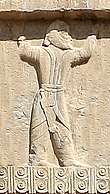
Achaemenid ruler Cyrus the Great conquered Sogdiana while campaigning in Central Asia in 546–539 BC,[13] a fact mentioned by the ancient Greek historian Herodotus in his Histories.[11] Darius I introduced the Aramaic writing system and coin currency to Central Asia, in addition to incorporating Sogdians into his standing army as regular soldiers and cavalrymen.[14] A contingent of Sogdian soldiers fought in the main army of Xerxes I during his ultimately failed invasion of Greece in 480 BC.[6][15] A Persian inscription from Susa claims that the palace there was adorned with lapis lazuli and carnelian originating from Sogdiana.[6]
Given the absence of any named satraps (i.e. Achaemenid provincial governors) for Sogdiana in historical records, modern scholarship has concluded that Sogdiana was governed from the satrapy of nearby Bactria.[16] The satraps were often relatives of the ruling Persian kings, especially sons who were not designated as the heir apparent.[11] Sogdiana likely remained under Persian control until roughly 400 BC, during the reign of Artaxerxes II.[17] Rebellious states of the Persian Empire took advantage of the weak Artaxerxes II, and some, such as Egypt, were able to regain their independence. Persia's massive loss of Central Asian territory is widely attributed to the ruler's lack of control. However, unlike Egypt, which was quickly recaptured by the Persian Empire, Sogdiana remained independent until it was conquered by Alexander the Great. When the latter invaded the Persian Empire, Pharasmanes, an already independent king of Khwarezm, allied with the Macedonians and sent troops to Alexander in 329 BC for his war against the Scythians of the Black Sea region (even though this anticipated campaign never materialized).[17]
During the Achaemenid period (550–330 BC), the Sogdians lived as a nomadic people much like the neighboring Yuezhi, who spoke Bactrian, an Indo-Iranian language closely related to Sogdian,[18] and were already engaging in overland trade. Some of them had also gradually settled the land to engage in agriculture.[19] Similar to how the Yuezhi offered tributary gifts of jade to the emperors of China, the Sogdians are recorded in Persian records as submitting precious gifts of lapis lazuli and carnelian to Darius I, the Persian king of kings.[19] Although the Sogdians were at times independent and living outside the boundaries of large empires, they never formed a great empire of their own like the Yuezhi, who established the Kushan Empire (30–375 AD) of Central and South Asia.[19]
Hellenistic period
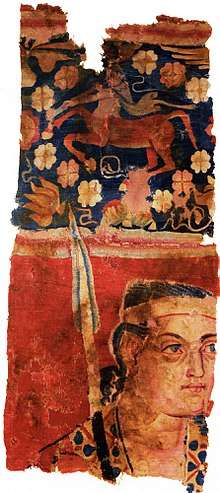
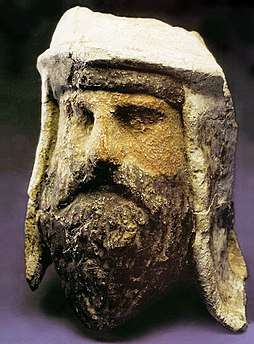
Right image: painted clay and alabaster head of a Zoroastrian priest wearing a distinctive Bactrian-style headdress, Takhti-Sangin, Tajikistan, 3rd–2nd century BC
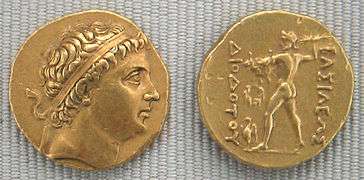

Right image: a barbaric copy of a coin of Euthydemus I, from the region of Sogdiana; the legend on the reverse is in Aramaic script.
A now independent and warlike Sogdiana, led at first by Bessus, the Achaemenid satrap of Bactria and claimant to the throne after assassinating Darius III in his flight from the Macedonian Greek army,[21][22] formed a border region insulating the Achaemenid Persians from the nomadic Scythians to the north and east.[23] The Sogdian Rock or Rock of Ariamazes, a fortress in Sogdiana, was captured in 327 BC by the forces of Alexander the Great, the basileus of Macedonian Greece and conqueror of the Persian Achaemenid Empire.[24] Oxyartes, a Sogdian nobleman of Bactria, had hoped to keep his daughter Roxana safe at the fortress of the Sogdian Rock, yet after its fall Roxana was soon wed to Alexander as one of his several wives.[25] Roxana, a Sogdian whose name Roshanak means "little star",[26][27][28] was the mother of Alexander IV of Macedon, who inherited his late father's throne in 323 BC (although the empire was soon divided in the Wars of the Diadochi).[29]
After an extended campaign putting down Sogdian resistance and founding military outposts manned by his Macedonian veterans, Alexander united Sogdiana with Bactria into one satrapy. The Sogdian nobleman and warlord Spitamenes (370–328 BC), allied with Scythian tribes, led an uprising against Alexander's forces. This revolt was put down by Alexander and his generals Amyntas, Craterus, and Coenus, with the aid of native Bactrian and Sogdian troops.[30] With the Scythian and Sogdian rebels defeated, Spitamenes was allegedly betrayed by his own wife and beheaded.[31] Pursuant with his own marriage to Roxana, Alexander encouraged his men to marry Sogdian women in order to discourage further revolt.[25][32] This included Apama, daughter of the rebel Spitamenes, who wed Seleucus I Nicator and bore him a son and future heir to the Seleucid throne.[33] According to the Roman historian Appian, Seleucus I named three new Hellenistic cities in Asia after her (see Apamea).[33][34]
The military power of the Sogdians never recovered. Subsequently, Sogdiana formed part of the Hellenistic Greco-Bactrian Kingdom, a breakaway state from the Seleucid Empire founded in 248 BC by Diodotus I, for roughly a century.[35][36] Euthydemus I, a former satrap of Sogdiana, seems to have held the Sogdian territory as a rival claimant to the Greco-Bactrian throne; his coins were later copied locally and bore Aramaic inscriptions.[37] The Greco-Bactrian king Eucratides I may have recovered sovereignty of Sogdia temporarily. Finally the area was occupied by nomads when the Scythians and Yuezhis overran it around 145 BC. From then until about 40 BC the Yuezhi tepidly minted coins imitating and still bearing the images of the Greco-Bactrian kings Eucratides I and Heliocles I, yet soon afterwards they began minting unique coins bearing the faces of their own rulers as a prelude to asserting themselves as a world power under the Kushan Empire.[38]
The American historian Homer H. Dubs offered the suggestion that a lost legion from the Roman army of Crassus that fought at Carrhae encountered and even fought a Chinese army of the Han Dynasty in the region:
... [In 36 BC a] Han expedition into central Asia, west of the Jaxartes River, apparently encountered and defeated a contingent of Roman legionaries. The Romans may have been the enslaved remnants of Crassus' army, defeated by the Parthians and forced to fight on their eastern frontier. Sogdiana (modern Bukhara), east of the Oxus River, on the Polytimetus River, was apparently the most easterly penetration ever made by Roman forces in Asia. The margin of Chinese victory appears to have been their crossbows, whose bolts and darts seem easily to have penetrated Roman shields and armour.[39]
However, this interpretation has been disputed by scholars such as Schuyler V. Cammann.[40]
Central Asia and the Silk Road
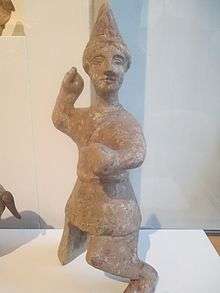
Right image: A grey pottery figurine of a Sogdian groom, Chinese Tang Dynasty, 7th century AD
Most merchants did not travel the entire Silk Road but would trade goods through middlemen based in oasis towns such as Khotan or Dunhuang. The Sogdians, however, established a trading network across the 1500 miles from Sogdiana to China. In fact, the Sogdians turned their energies to trade so thoroughly that the Saka of the Kingdom of Khotan called all merchants suli, "Sogdian", whatever their culture or ethnicity.[41] Unlike the empires of antiquity, the Sogdian region was not a territory confined within fixed borders, but rather a network of city-states, from one oasis to another, linking Sogdiana to Byzantium, India, Indochina and China.[42] Sogdian contacts with China were initiated by the embassy of the Chinese explorer Zhang Qian during the reign of Emperor Wu (r. 141–87 BC) of the former Han dynasty. Zhang wrote a report of his visit to the Western Regions in Central Asia and named the area of Sogdiana as "Kangju".[43]
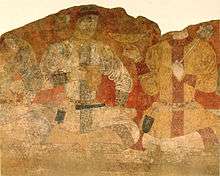
Right image: Detail from another wall mural from Varakhsha, 6th century AD, showing tigers attacking a man riding a war elephant
Following Zhang Qian's embassy and report, commercial Chinese relations with Central Asia and Sogdiana flourished,[44] as many Chinese missions were sent throughout the 1st century BC. In his Shiji published in 94 BC, Chinese historian Sima Qian remarked that "the largest of these embassies to foreign states numbered several hundred persons, while even the smaller parties included over 100 members ... In the course of one year anywhere from five to six to over ten parties would be sent out."[45] In terms of the silk trade, the Sogdians also served as the primary middlemen between the Chinese Han Empire and the Parthian Empire of the Middle East and West Asia.[46] Sogdians played a major role in facilitating trade between China and Central Asia along the Silk Roads as late as the 10th century, their language serving as a lingua franca for Asian trade as far back as the 4th century.[47][48]

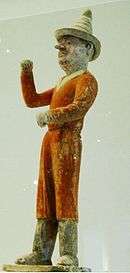
Right image: ceramic figurine of a Sogdian merchant in northern China, Tang Dynasty, 7th century AD

Right image: Chinese-influenced Sogdian coin, from Kelpin, 8th century, British Museum
Subsequent to their domination by Alexander the Great, the Sogdians from the city of Marakanda (Samarkand) became dominant as traveling merchants, occupying a key position along the ancient Silk Road.[49] They played an active role in the spread of faiths such as Manicheism, Zoroastrianism, and Buddhism along the Silk Road. The Chinese Sui Shu (Book of Sui) describes Sogdians as "skilled merchants" who attracted many foreign traders to their land to engage in commerce.[50] They were described by the Chinese as born merchants, learning their commercial skills at an early age. It appears from sources, such as documents found by Sir Aurel Stein and others, that by the 4th century they may have monopolized trade between India and China. A letter written by Sogdian merchants dated 313 AD and found in the ruins of a watchtower in Gansu was intended to be sent to merchants in Samarkand, warning them that after Liu Cong of Han Zhao sacked Luoyang and the Jin emperor fled the capital, there was no worthwhile business there for Indian and Sogdian merchants.[15][51] Furthermore, in 568 AD a Turko-Sogdian delegation travelled to the Roman emperor in Constantinople to obtain permission to trade and in the following years commercial activity between the states flourished.[52] Put simply, the Sogdians dominated trade along the Silk Road from the 2nd century BC until the 10th century.[41]
Suyab and Talas in modern-day Kyrgyzstan were the main Sogdian centers in the north that dominated the caravan routes of the 6th to 8th centuries.[53] Their commercial interests were protected by the resurgent military power of the Göktürks, whose empire was built on the political power of the Ashina clan and economic clout of the Sogdians.[54][55][56] Sogdian trade, with some interruptions, continued into the 9th century. For instance, camels, women, girls, silver, and gold were seized from Sogdia during a raid by Qapaghan Qaghan (692–716), ruler of the Second Turkic Khaganate.[57] In the 10th century Sogdiana was incorporated into the Uighur Empire, which until 840 encompassed northern Central Asia. This khaganate obtained enormous deliveries of silk from Tang China in exchange for horses, in turn relying on the Sogdians to sell much of this silk further west.[58] Peter B. Golden writes that the Uyghurs not only adopted the writing system and religious faiths of the Sogdians, such as Manichaeism, Buddhism, and Christianity, but also looked to the Sogdians as "mentors" while gradually replacing them in their roles as Silk Road traders and purveyors of culture.[59] Muslim geographers of the 10th century drew upon Sogdian records dating to 750–840. After the end of the Uyghur Empire, Sogdian trade underwent a crisis. Following the Muslim conquest of Transoxiana in the 8th century, the Samanids resumed trade on the northwestern road leading to the Khazars and the Urals and the northeastern one toward the nearby Turkic tribes.[55]
During the 5th and 6th century many Sogdians took up residence in the Hexi Corridor where they retained autonomy in terms of governance and had a designated official administrator known as a sabao, which suggests their importance to the socioeconomic structure of China. The Sogdian influence on trade in China is also made apparent by a Chinese document which lists taxes paid on caravan trade in the Turpan region and shows that twenty-nine out of the thirty-five commercial transactions involved Sogdian merchants, and in thirteen of those cases both the buyer and the seller were Sogdian.[60] Trade goods brought to China included grapes, alfalfa, and Sassanian silverware, as well as glass containers, Mediterranean coral, brass Buddhist images, Roman wool cloth, and Baltic amber. These were exchanged for Chinese paper, copper, and silk.[41] In the 7th century the Chinese Buddhist pilgrim Xuanzang noted with approval that Sogdian boys were taught to read and write at the age of five, though their skill was turned to trade, disappointing the scholarly Xuanzang. He also recorded the Sogdians working in other capacities such as farmers, carpetweavers, glassmakers, and woodcarvers.[61]
Trade and diplomacy with the Byzantine Empire
Historical knowledge about Sogdia is somewhat hazy during the period of the Parthian Empire (247 BC – 224 AD) in Persia.[62][63] The subsequent Sasanian Empire of Persia conquered and incorporated Sogdia as a satrapy in 260,[62] an inscription dating to the reign of Shapur I noting that its limits formed the northeastern Sasanian borderlands with the Kushan Empire.[63] However, by the 5th century the region was captured by the rival Hephthalite Empire.[62]
Shortly after the smuggling of silkworm eggs into the Byzantine Empire from China by Nestorian Christian monks, the 6th-century Byzantine historian Menander Protector writes of how the Sogdians attempted to establish a direct trade of Chinese silk with the Byzantine Empire. After forming an alliance with the Sasanian ruler Khosrow I to defeat the Hephthalite Empire, Istämi, the Göktürk ruler of the First Turkic Khaganate, was approached by Sogdian merchants requesting permission to seek an audience with the Sassanid king of kings for the privilege of traveling through Persian territories in order to trade with the Byzantines.[46] Istämi refused the first request, but when he sanctioned the second one and had the Sogdian embassy sent to the Sassanid king, the latter had the members of the embassy poisoned.[46] Maniah, a Sogdian diplomat, convinced Istämi to send an embassy directly to Byzantium's capital Constantinople, which arrived in 568 and offered not only silk as a gift to Byzantine ruler Justin II, but also proposed an alliance against Sassanid Persia. Justin II agreed and sent an embassy to the Turkic Khaganate, ensuring the direct silk trade desired by the Sogdians.[46][64][65]
It appears, however, that direct trade with the Sogdians remained limited in light of the small amount of Roman and Byzantine coins found in Central Asian and Chinese archaeological sites belonging to this era. Although Roman embassies apparently reached Han China from 166 AD onwards,[66] and the ancient Romans imported Han Chinese silk while the Han-dynasty Chinese imported Roman glasswares as discovered in their tombs,[67][68] Valerie Hansen (2012) wrote that no Roman coins from the Roman Republic (507–27 BC) or the Principate (27 BC – 330 AD) era of the Roman Empire have been found in China.[69] However, Warwick Ball (2016) upends this notion by pointing to a hoard of sixteen Roman coins found at Xi'an, China (formerly Chang'an), dated to the reigns of various emperors from Tiberius (14–37 AD) to Aurelian (270–275 AD).[70] The earliest gold solidus coins from the Eastern Roman Empire found in China date to the reign of Byzantine emperor Theodosius II (r. 408–450) and altogether only forty-eight of them have been found (compared to thirteen-hundred silver coins) in Xinjiang and the rest of China.[69] The use of silver coins in Turfan persisted long after the Tang campaign against Karakhoja and Chinese conquest of 640, with a gradual adoption of Chinese bronze coinage over the course of the 7th century.[69] The fact that these Eastern Roman coins were almost always found with Sasanian Persian silver coins and Eastern Roman gold coins were used more as ceremonial objects like talismans confirms the pre-eminent importance of Greater Iran in Chinese Silk Road commerce of Central Asia compared to Eastern Rome.[71]
Sogdian merchants, generals, and statesmen of Imperial China
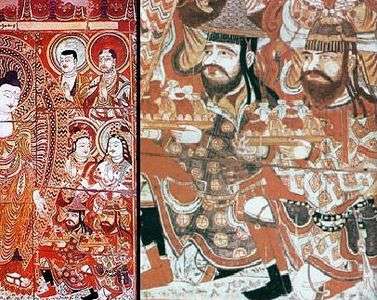
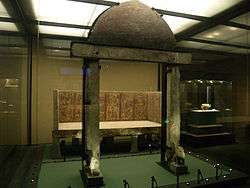
Right image: the stone tomb gate and couch of An Jia (安伽), a Northern Zhou (557–581 AD) period Sogdian nobleman,[72] excavated from Chang'an (modern Xi'an), China; An Jia held the title of Sar-pav of Tongzhou prefecture and was in charge of commercial affairs of foreign merchants from Middle Asia, who made businesses in China; the stone gate is flanked by two lions and the horizontal tablet is carved with a sacrificial scene in accordance with Zoroastrianism
Aside from the Sogdians of Central Asia who acted as middlemen in the Silk Road trade, other Sogdians settled down in China for generations. Although many Sogdians had fled Luoyang following the collapse of the Jin Dynasty's control over northern China in 311 AD, some Sogdians continued living in Gansu.[51] Sogdian families living in Gansu created funerary epitaphs explaining the history of their illustrious houses. For instance, a sabao (薩保, from Sanskrit sarthavaha, meaning caravan leader)[64] from Anxi (western Sogdiana or Parthia) who lived in Jiuquan during the Northern Wei (386 – 535 AD), was the ancestor of An Tugen, a man who rose from a common merchant to become a top ranking minister of state for the Northern Qi (550 – 577 AD).[50] Valerie Hansen asserts that around this time and extending into the Tang Dynasty (618 – 907 AD), the Sogdians "became the most influential of the non-Chinese groups resident in China," settling throughout Chinese territory, marrying Chinese women, purchasing land, with newcomers living there permanently instead of returning to their homelands in Sogdiana.[50] They were concentrated in large numbers around Luoyang and Chang'an, and also Xiangyang in present-day Hubei, building Zoroastrian temples to service their communities once they reached the threshold of roughly 100 households.[50] From the Northern Qi to Tang periods, the leaders of these communities, the sabao, were incorporated into the official hierarchy of state officials.[50] Their burial practices blended both Chinese forms such as carved funerary beds with Zoroastrian sensibilities in mind, such as separating the body from both the earth and water.[73]

In addition to being merchants, monks, and government officials, Sogdians also served as soldiers in the Tang military.[77] An Lushan, whose father was Sogdian and mother a Gokturk, rose to the position of a military governor (jiedushi) in the northeast before leading the An Lushan Rebellion (755 – 763 AD), which split the loyalties of the Sogdians in China.[77] The An Lushan rebellion was supported by many Sogdians, and in its aftermath many of them were slain or changed their names to escape their Sogdian heritage,[78] so that little is known about the Sogdian presence in North China since that time.[79] Sogdians continued as active traders in China following the defeat of the rebellion, but many of them were compelled to hide their ethnic identity. A prominent case was An Chongzhang, Minister of War, and Duke of Liang who, in 756, asked Emperor Suzong of Tang to allow him to change his name to Li Baoyu because of his shame in sharing the same surname with the rebel leader.[77] This change of surnames was enacted retroactively for all of his family members, so that his ancestors would also be bestowed the surname Li.[77]
During the Tang and subsequent Five Dynasties and Song Dynasty, a large community of Sogdians also existed in the multicultural entrepôt of Dunhuang, Gansu, a major center of Buddhist learning and home to the Buddhist Mogao Caves.[80] Although Dunhuang and the Hexi Corridor were captured by the Tibetan Empire after the An Lushan Rebellion, in 848 the ethnic Han Chinese general Zhang Yichao (799–872) managed to wrestle control of the region from the Tibetans during their civil war, establishing the Guiyi Circuit under Emperor Xuānzong of Tang (r. 846–859).[81][82] Although the region occasionally fell under the rule of different states, it retained its multilingual nature as evidenced by an abundance of manuscripts (religious and secular) in Chinese and Tibetan, but also Sogdian, Khotanese (another Eastern Iranian language native to the region), Uyghur, and Sanskrit.[83]
From the Chinese surnames listed in the Tang-era Dunhuang manuscript Pelliot chinois 3319V (containing the following text: 石定信右全石丑子石定奴福延福全保昌張丑子李千子李定信), the names of the Nine Zhaowu Clans (昭武九姓),[76] the prominent ethnic Sogdian communities of China, have been deduced. Each "clan" is indicating a different place of birth, as the Sogdians were from different city-states, and used the name of their hometown as their Chinese surname.[84] Of these the most common Sogdian surname throughout China was Shí (石, generally given to those from Chach, modern Tashkent), whereas the surnames Shǐ (史, from Kesh, modern Shahrisabz), An (安, from Bukhara), Mi (米, from Panjakent), Kāng (康, from Samarkand), Cáo (曹, from Kabudhan, north of the Zeravshan River), and Hé (何, from Kushaniyah) appear frequently in Dunhuang manuscripts and registers.[76][85] The influence of Sinicized and multilingual Sogdians during this Guiyijun (歸義軍) period (c. 850 – c. 1000 AD) of Dunhuang is evident in a large number of manuscripts written in Chinese characters from left to right instead of vertically, mirroring the direction of how the Sogdian alphabet is read.[86] Sogdians of Dunhuang also commonly formed and joined lay associations among their local communities, convening at Sogdian-owned taverns in scheduled meetings mentioned in their epistolary letters.[87] Sogdians living in Turfan under the Tang dynasty and Gaochang Kingdom engaged in a variety of occupations that included: farming, military service, painting, leather crafting and selling products such as iron goods.[76] The Sogdians had been migrating to Turfan since the 4th century, yet the pace of migration began to climb steadily with the Muslim conquest of Persia and Fall of the Sasanian Empire in 651, followed by the Islamic conquest of Samarkand in 712.[76]
Arab Muslim conquest of Central Asia
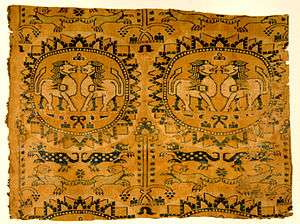

Right image: a caftan worn by a horseman along the Silk Road, 8th–10th century AD, Metropolitan Museum of Art
Qutayba ibn Muslim (669–716), Governor of Greater Khorasan under the Umayyad Caliphate (661–750), initiated the Muslim conquest of Sogdia during the early 8th century, with the local ruler of Balkh offering him aid as an Umayyad ally.[63][88] However, when his successor al-Jarrah ibn Abdallah governed Khorasan (717–719), many native Sogdians, who had converted to Islam, began to revolt when they were no longer exempt from paying the tax on non-Muslims, the jizya, because of a new law stating that proof of circumcision and literacy in the Quran was necessary for new converts.[63][89] With the aid of the Turkic Turgesh, the Sogdians were able to expel the Umayyad Arab garrison from Samarkand and Umayyad attempts to restore power there were rebuffed until the arrival of Sa'id ibn Amr al-Harashi (fl. 720–735). The Sogdian ruler (i.e. ikhshid) of Samarkand, Gurak, who had previously overthrown the pro-Umayyad Sogdian ruler Tarkhun in 710, decided that resistance against al-Harashi's large Arab force was pointless and thereafter persuaded his followers to declare allegiance to the Umayyad governor.[89] Divashtich (r. 706–722), the Sogdian ruler of Panjakent, led his forces to the Zarafshan Range (near modern Zarafshan, Tajikistan), whereas the Sogdians following Karzanj, the ruler of Pai (modern Kattakurgan, Uzbekistan), fled to the Principality of Farghana, where their ruler at-Tar (or Alutar) promised them safety and refuge from the Umayyads. However, at-Tar secretly informed al-Harashi of the Sogdians hiding in Khujand, who were then slaughtered by al-Harashi's forces after their arrival.[90]

The Umayyads fell in 750 to the Abbasid Caliphate, which quickly asserted itself in Central Asia after winning the Battle of Talas (along the Talas River in modern Talas Oblast, Kyrgyzstan) in 751 against the Chinese Tang Dynasty. This conflict incidentally introduced Chinese papermaking to the Islamic world.[91] The cultural consequences and political ramifications of this battle meant the retreat of the Chinese empire from Central Asia. It also allowed for the rise of the Samanid Empire (819–999), a Persian state centered at Bukhara (in what is now modern Uzbekistan) that nominally observed the Abbasids as their overlords, yet retained a great deal of autonomy and upheld the mercantile legacy of the Sogdians.[91] Yet the Sogdian language gradually declined in favor of the Persian language of the Samanids (the ancestor to the modern Tajik language), the spoken language of renowned poets and intellectuals of the age such as Ferdowsi (940–1020).[91] So too did the original religions of the Sogdians decline; Zoroastrianism, Buddhism, Manichaeism, and Nestorian Christianity disappeared in the region by the end of the Samanid period.[91] The Samanids were also responsible for converting the surrounding Turkic peoples to Islam, which presaged the conquest of their empire in 999 by an Islamic Turkic power, the Kara-Khanid Khanate (840–1212).[92]
During the early 13th century Khwarezmia was invaded by the early Mongol Empire and its ruler Genghis Khan destroyed the once vibrant cities of Bukhara and Samarkand.[93] However, in 1370 Samarkand saw a revival as the capital of the Timurid Empire. The Turko-Mongol ruler Timur forcefully brought artisans and intellectuals from across Asia to Samarkand, transforming it not only into a trade hub but also one of the most important cities of the Islamic world.[94]
Language and culture
The 6th century is thought to be the peak of Sogdian culture, judging by its highly developed artistic tradition. By this point, the Sogdians were entrenched in their role as the central Asian traveling and trading merchants, transferring goods, culture and religion.[95] During the Middle Ages, the valley of the Zarafshan around Samarkand retained its Sogdian name, Samarkand.[7] According to the Encyclopædia Britannica, medieval Arab geographers considered it one of the four fairest regions of the world.[7] Where the Sogdians moved in considerable numbers, their language made a considerable impact. For instance, during China's Han dynasty, the native name of the Tarim Basin city-state of Loulan was "Kroraina," possibly from Greek due to nearby Hellenistic influence.[96] However, centuries later in 664 AD the Tang Chinese Buddhist monk Xuanzang labelled it as "Nafupo" (納縛溥), which according to Dr. Hisao Matsuda is a transliteration of the Sogdian word Navapa meaning "new water."[97]
Art
The Afrasiab paintings of the 6th to 7th centuries in Samarkand, Uzbekistan offer a rare surviving example of Sogdian art. The paintings, showing scenes of daily life and events such as the arrival of foreign ambassadors, are located within the ruins of aristocratic homes. It is unclear if any of these palatial residences served as the official palace of the rulers of Samarkand.[98] The oldest surviving Sogdian monumental wall murals date to the 5th century and are located at Panjakent, Tajikistan.[99] In addition to revealing aspects of their social and political lives, Sogdian art has also been instrumental in aiding historians' understanding of their religious beliefs. For instance, it is clear that Buddhist Sogdians incorporated some of their own Iranian deities into their version of the Buddhist Pantheon. At Zhetysu, Sogdian gilded bronze plaques on a Buddhist temple show a pairing of a male and female deity with outstretched hands holding a miniature camel, a common non-Buddhist image similarly found in the paintings of Samarkand and Panjakent.[100]
Language
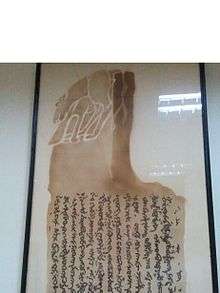
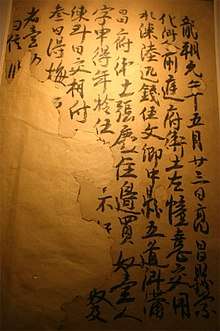
Right image: a contract written in Chinese from the Tang dynasty in Turpan that records the purchase of a 15-year-old slave for six bolts of plain silk and five Chinese coins, dated 661 AD
The Sogdians spoke an Eastern Iranian language called Sogdian, closely related to Bactrian, Khwarazmian, and the Khotanese language Saka, widely spoken Eastern Iranian languages of Central Asia in ancient times.[62][101] Sogdian was also prominent in the oasis city-state of Turfan in the Tarim Basin region of Northwest China (in modern Xinjiang).[101] Judging by the Sogdian Bugut inscription of Mongolia written c. 581, the Sogdian language was also an official language of the First Turkic Khaganate established by the Gokturks.[65][101]
Sogdian was written largely in three scripts: the Sogdian alphabet, the Syriac alphabet, and the Manichaean alphabet, each derived from the Aramaic alphabet,[102][103] which had been widely used in both the Achaemenid and Parthian empires of ancient Iran.[14][104] The Sogdian alphabet formed the basis of the Old Uyghur alphabet of the 8th century, which in turn was used to create the Mongolian script of the early Mongol Empire during the 13th century.[105]
The Yaghnobi people living in the Sughd province of Tajikistan still speak a dialect of the Sogdian language.[63][106] Yaghnobi is largely a continuation of the medieval Sogdian dialect from the Osrushana region of the western Fergana Valley.[107] The great majority of the Sogdian people assimilated with other local groups such as the Bactrians, Chorasmians, and in particular with Persians and came to speak Persian. In 819 the Persians founded the Samanid Empire in the region. They are among the ancestors of the modern Tajiks. Numerous Sogdian cognates can be found in the modern Tajik language, although the latter is a Western Iranian language.
Clothing
Right image: a female mannequin showing the medieval-era clothing for Sogdian women from Afrasiyab (Samarkand), Tajikistan National Museum, Dushanbe
Early medieval Sogdian costumes can be divided in two periods: Hephtalitic (5th and 6th centuries) and Turkic (7th and early 8th centuries). The latter did not become common immediately after the political dominance of the Gökturks but only in c. 620 when, especially following Western Turkic Khagan Ton-jazbgu's reforms, Sogd was Turkized and the local nobility was officially included in the Khaganate's administration.[108]
For both sexes clothes were tight-fitted, and narrow waists and wrists were appreciated. The silhouettes for grown men and young girls emphasized wide shoulders and narrowed to the waist; the silhouettes for female aristocrats were more complicated. The Sogdian clothing underwent a thorough process of Islamization in the ensuing centuries, with few of the original elements remaining. In their stead, turbans, kaftans, and sleeved coats became more common.[108]
Religious beliefs

Right image: Chinese Tang Dynasty era statues of Sogdian merchants
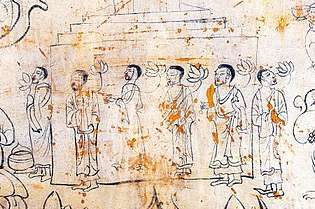
The Sogdians practiced a variety of religious faiths. However, Zoroastrianism was most likely their main religion as demonstrated by material evidence. For instance, the discovery of murals depicting votaries making offers before fire-holders and ossuaries from Samarkand, Panjakent and Er-Kurgan held the bones of the dead in accordance with Zoroastrian ritual. At Turfan, Sogdian burials shared similar features with traditional Chinese practices, yet they still retained essential Zoroastrian rituals, such as allowing the bodies to be picked clean by scavengers before burying the bones in ossuaries.[76] They also sacrificed animals to Zoroastrian deities, including the supreme deity Ahura Mazda.[76] Zoroastrianism remained the dominant religion among Sogdians until after the Islamic conquest, when they gradually converted to Islam, as is shown by Richard Bulliet's "conversion curve".[110]
The Sogdian religious texts found in China and dating to the Northern Dynasties, Sui, and Tang are mostly Buddhist (translated from Chinese sources), Manichaean and Nestorian Christian, with only a small minority of Zoroastrian texts.[111] But tombs of Sogdian merchants in China dated to the last third of the 6th century show predominantly Zoroastrian motifs or Zoroastrian-Manichaean syncretism, while archaeological remains from Sogdiana appear fairly Iranian and conservatively Zoroastrian.[111]
However, the Sogdians epitomized the religious plurality found along the trade routes. The largest body of Sogdian texts are Buddhist, and Sogdians were among the principal translators of Buddhist sutras into Chinese. However, Buddhism did not take root in Sogdiana itself.[112] Additionally, the Bulayiq monastery to the north of Turpan contained Sogdian Christian texts and there are numerous Manichaean texts in Sogdiana from nearby Qocho.[113] The reconversion of Sogdians from Buddhism to Zoroastrianism coincided with the adoption of Zoroastrianism by the Sassanid Empire of Persia.[64] From the 4th century onwards, Sogdian Buddhist pilgrims left behind evidence of their travels along the steep cliffs of the Indus River and Hunza Valley. It was here that they carved images of the Buddha and holy stupas in addition to their full names, in hopes that the Buddha would grant them his protection.[114]
The Sogdians also practiced the faith of Mani, Manichaeism, a faith that they spread to the Uyghurs. The Uyghur Khaganate (744–840 AD) developed close ties to Tang China once they aided the Tang in suppressing the rebellion of An Lushan and his Göktürk successor Shi Siming, establishing an annual trade relationship of one million bolts of Chinese silk for one hundred thousand horses.[58] The Uyghurs relied on Sogdian merchants to sell much of this silk further west along the Silk Road, a symbiotic relationship that led many Uyghurs to adopt Manichaeism from the Sogdians.[58] However, evidence of Manichaean liturgical and canonical texts of Sogdian origin remains fragmentary and sparse compared to their corpus of Buddhist writings.[115] The Uyghurs were also followers of Buddhism. For instance, they can be seen wearing silk robes in the praṇidhi scenes of the Uyghur Bezeklik Buddhist murals of Xinjiang, China, particularly Scene 6 from Temple 9 showing Sogdian donors to the Buddha.[75][116]
In addition to Puranic cults, there were five Hindu deities known to have been worshipped in Sogdiana.[117] These were Brahma, Indra, Mahadeva (Shiva), Narayana, and Vaishravana; the gods Brahma, Indra, and Shiva were known by their Sogdian names Zravan, Adbad and Veshparkar, respectively.[117] Durga, a mother goddess in Shaktism, may be represented in Sogdian art as a four-armed goddess riding atop a lion.[117] As seen in an 8th-century mural from Panjakent, portable fire altars can be "associated" with Mahadeva-Veshparkar, Brahma-Zravan, and Indra-Abdab, according to Braja Bihārī Kumar.[117]
Among the Sogdian Christians known in China from inscriptions and texts were An Yena, a Christian from An country (Bukhara). Mi Jifen a Christian from Mi country (Maymurgh), Kang Zhitong, a Sogdian Christian cleric from Kang country (Samarkand), Mi Xuanqing a Sogdian Christian cleric from Mi country (Maymurgh), Mi Xuanying, a Sogdian Christian cleric from Mi country (Maymurgh), An Qingsu, a Sogdian Christian monk from An country (Bukhara).[118][119][120]
When visiting Yuan-era Zhenjiang, Jiangsu, China during the late 13th century, the Venetian explorer and merchant Marco Polo noted that a large number of Christian churches had been built there. His claim is confirmed by a Chinese text of the 14th century explaining how a Sogdian named Mar-Sargis from Samarkand founded six Nestorian Christian churches there in addition to one in Hangzhou during the second half of the 13th century.[121] Nestorian Christianity had existed in China earlier during the Tang Dynasty when a Persian monk named Alopen came to Chang'an in 653 to proselytize, as described in a dual Chinese and Syriac language inscription from Chang'an (modern Xi'an) dated to the year 781.[122] Within the Syriac inscription is a list of priests and monks, one of whom is named Gabriel, the archdeacon of "Xumdan" and "Sarag", the Sogdian names for the Chinese capital cities Chang'an and Luoyang, respectively.[123] In regards to textual material, the earliest Christian gospel texts translated into Sogdian coincide with the reign of the Sasanian Persian monarch Yazdegerd II (r. 438–457) and were translated from the Peshitta, the standard version of the Bible in Syriac Christianity.[124]
Commerce and slave trade
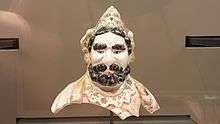
Slavery existed in China since ancient times, although during the Han dynasty the proportion of slaves to the overall population was roughly 1%,[125] far lower than the estimate for the contemporary Greco-Roman world (estimated at about 15% of the entire population).[126][127] During the Tang period slaves were not allowed to marry a commoner's daughter, were not allowed to have sexual relations with any female member of their master's family, and although fornication with female slaves was forbidden in the Tang code of law it was widely practiced.[128] Manumission was also permitted when a slave woman gave birth to her master's son, which allowed for her elevation to the legal status of a commoner, yet she could only live as a concubine and not as the wife of her former master.[129]
Sogdian and Chinese merchants regularly traded in slaves in and around Turpan during the Tang dynasty. Turpan under Tang dynasty rule was a center of major commercial activity between Chinese and Sogdian merchants. There were many inns in Turpan. Some provided Sogdian sex workers with an opportunity to service the Silk Road merchants, since the official histories report that there were markets in women at Kucha and Khotan.[130] The Sogdian-language contract buried at the Astana graveyard demonstrates that at least one Chinese man bought a Sogdian girl in 639 AD. One of the archaeologists who excavated the Astana site, Wu Zhen, contends that, although many households along the Silk Road bought individual slaves, as we can see in the earlier documents from Niya, the Turpan documents point to a massive escalation in the volume of the slave trade.[131] In 639 a female Sogdian slave was sold to a Chinese man as recorded in an Astana cemetery legal document written in Sogdian.[132] Khotan and Kucha were places where women were commonly sold, with ample evidence of the slave trade in Turfan thanks to contemporary textual sources that have survived.[133][134] In Tang poetry Sogdian girls also frequently appear as serving maids in the taverns and inns of the capital Chang'an.[135]
Sogdian slave girls and their Chinese male owners made up the majority of Sogdian female-Chinese male pairings, while free Sogdian women were the most common spouse of Sogdian men. A smaller number of Chinese women were paired with elite Sogdian men. Sogdian man-and-woman pairings made up eighteen out of twenty-one marriages according to existing documents.[134][136]
A document dated 731 AD reveals that precisely forty bolts of silk were paid to a certain Mi Lushan, a slave dealing Sogdian, by a Chinese man named Tang Rong (唐榮) of Chang'an, for the purchase of an eleven-year-old girl. A person from Xizhou, a Tokharistani (i.e. Bactrian), and three Sogdians verified the sale of the girl.[134][137]
Modern historiography
In 1916 the French Sinologist and historian Paul Pelliot used Tang Chinese manuscripts excavated from Dunhuang, Gansu to identify an ancient Sogdian colony south of Lop Nur in Xinjiang (Northwest China), which he argued was the base for the spread of Buddhism and Nestorian Christianity in China.[138] In 1926 Japanese scholar Kuwabara compiled evidence for Sogdians in Chinese historical sources and by 1933 Chinese historian Xiang Da published his Tang Chang'an and Central Asian Culture detailing the Sogdian influence on Chinese social religious life in the Tang-era Chinese capital city.[138] The Canadian Sinologist Edwin G. Pulleyblank published an article in 1952 demonstrating the presence of a Sogdian colony founded in Six Hu Prefectures of the Ordos Loop during the Chinese Tang period, composed of Sogdians and Turkic peoples who migrated from the Mongolian steppe.[138] The Japanese historian Ikeda on wrote an article in 1965 outlining the history of the Sogdians inhabiting Dunhuang from the beginning of the 7th century, analyzing lists of their Sinicized names and the role of Zoroastrianism and Buddhism in their religious life.[139] Yoshida Yutaka and Kageyama Etsuko, Japanese ethnographers and linguists of the Sogdian language, were able to reconstruct Sogdian names from forty-five different Chinese transliterations, noting that these were common in Turfan whereas Sogdians living closer to the center of Chinese civilization for generations adopted traditional Chinese names.[76]
Notable Sogdians
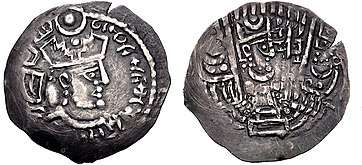
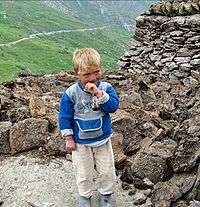

- Alexander IV of Macedon, the Basilius of Macedon, son of Alexander the Great and Roxana, the latter a daughter of the Sogdian nobleman Oxyartes,[25][26][27] making Alexander IV half-Sogdian
- An Lushan (安祿山),[77] a military leader of Sogdian (from his father's side) and Tūjué origin during the Tang dynasty in China; he rose to prominence by fighting (and losing) frontier wars between 741 and 755. Later, he precipitated the catastrophic An Lushan Rebellion, which lasted from 755 to 763 and led to the decline of the Tang dynasty.
- An Qingxu (安慶緒), son of An Lushan
- An Chonghui (安重誨), a minister of China's Later Tang
- An Congjin (安從進), a general of Later Tang and China's Later Jin (Five Dynasties)
- An Chongrong (安重榮), a general of the China's Later Jin (Five Dynasties)
- Antiochus I Soter,[33] second king of the Seleucid Empire, who was half-Sogdian and Macedonian-Greek due to his maternal (Apama) and paternal (Seleucus I Nicator) lineage, respectively
- Apama,[33] daughter of Spitamenes (see below) and wife of Seleucus I Nicator, founder of the Seleucid Empire
- Azanes,[6] son of Artaios, who led a contingent of Sogdian troops in the Persian army of Xerxes I during the Second Persian invasion of Greece in 480 BC
- Divashtich,[141] 8th-century ruler of Panjakent
- Fazang,[142] Buddhist monk of the 7th century, a colleague of Xuanzang
- Gurak,[89] 8th-century ruler of Samarkand
- Kang Senghui (康僧會),[143] Buddhist monk of the 3rd century who lived in Jiaozhi (modern-day Vietnam) during the Three Kingdoms period
- Kang Jing (康景)?- a possible Sogdian who worked at the Ming dynasty Mansion of the Prince of Qin (明朝藩王列表 (秦王系)) as a servant[144][145]
- Khaydhar ibn Kawus al-Afshin,[146] a general of the Abbasid caliphate and a vassal of the Abbasids as the prince of Osrushana during the 9th century
- Kaydar Nasr ibn 'Abdallah,[147] Abbasid governor of Egypt during the 9th century
- Li Baoyu (李抱玉),[77] formerly known as An Chongzhang (安重璋) and ennobled as Duke Zhaowu of Liang (涼昭武公), a general of the Chinese Tang Dynasty who fought against the rebellion of An Lushan and the Tibetan Empire
- Malik ibn Kaydar,[148] a 9th-century general of the Abbasid caliphate.
- Muzaffar ibn Kaydar, son of Kaydar Nasr ibn 'Abdallah (see above), and yet another Abbasid governor of Egypt during the 9th century
- Oxyartes,[25][26][27] Sogdian warlord from Bactria, follower of Bessus, and father of Roxana, the wife of Alexander the Great
- Roxana,[25][26][27][149] the primary wife of Alexander the Great during the 4th century BC
- Spitamenes,[30] a Sogdian warlord who led an uprising against Alexander the Great in the late 4th century BC
- Tarkhun,[89] 8th-century ruler of Samarkand
- Abu'l-Saj Devdad, emir and official of the Abbasid caliphate and ancestor of the Sajid dynasty[150]
Diaspora areas
- A community of merchant Sogdians resided in Northern Qi era Ye.[151]
- Turkic Khaganate era Inner Mongolia.[152]
See also
- Ancient Iranian peoples
- Buddhism in Afghanistan
- Buddhism in Khotan
- Étienne de la Vaissière
- History of Central Asia
- Huteng
- Iranian languages
- Margiana
- List of ancient Iranian peoples
- Philip (satrap)
- Poykent
- Sogdian Daēnās
- Sughd Province
- Kangju
- Tocharians
- Tomb of Wirkak
- Tomb of Yu Hong
- Yaghnobi people
- Yagnob Valley
- Yazid ibn al-Muhallab
References
Citations
- Jacques Gernet (31 May 1996). A History of Chinese Civilization. Cambridge University Press. pp. 286–. ISBN 978-0-521-49781-7.
- "Soghdian Kai Yuans (lectured at the Dutch 1994-ONS meeting)". T.D. Yih and J. de Kreek (hosted on the Chinese Coinage Website). 1994. Retrieved 8 June 2018.
- "Samarqand's Cast Coinage of the Early 7th–Mid-8th Centuries AD: Assessment based on Chinese sources and numismatic evidence". Andrew Reinhard (Pocket Change – The blog of the American Numismatic Society). 12 August 2016. Retrieved 9 June 2018.
- Mark J. Dresden (1981), "Introductory Note," in Guitty Azarpay, Sogdian Painting: the Pictorial Epic in Oriental Art, Berkeley, Los Angeles, London: University of California Press, pp 2–3, ISBN 0-520-03765-0.
- "Avesta: Vendidad (English): Fargard 1". Avesta.org. Archived from the original on 4 October 2016. Retrieved 4 January 2016.
- Mark J. Dresden (2003), "Sogdian Language and Literature", in Ehsan Yarshater, The Cambridge History of Iran, Vol III: The Seleucid, Parthian, and Sasanian Periods, Cambridge: Cambridge University Press, p. 1216, ISBN 0-521-24699-7.
- Chisholm, Hugh, ed. (1911). . Encyclopædia Britannica (11th ed.). Cambridge University Press.
- Szemerényi 1980, pp. 45–46.
- Szemerényi 1980, pp. 26–36.
- Szemerényi 1980, p. 39.
- Antoine Simonin. (8 January 2012). "Sogdiana." Ancient History Encyclopedia. Retrieved 31 August 2016.
- É. de La Vaissière (2011), "SOGDIANA iii. HISTORY AND ARCHEOLOGY," Encyclopædia Iranica, online edition (accessed on 31 August 2016).
- Kirill Nourzhanov, Christian Bleuer (2013), Tajikistan: a Political and Social History, Canberra: Australian National University Press, p. 12, ISBN 978-1-925021-15-8.
- Christoph Baumer (2012), The History of Central Asia: the Age of the Steppe Warriors, London, New York: I.B. Tauris, p. 202–203, ISBN 978-1-78076-060-5.
- Mark J. Dresden (1981), "Introductory Note," in Guitty Azarpay, Sogdian Painting: the Pictorial Epic in Oriental Art, Berkeley, Los Angeles, London: University of California Press, p. 3, ISBN 0-520-03765-0.
- Pierre Briant (2002), From Cyrus to Alexander: a History of the Persian Empire, trans. Peter T. Daniels, Winona Lake: Eisenbrauns, p. 746, ISBN 1-57506-120-1.
- Christoph Baumer (2012), The History of Central Asia: the Age of the Steppe Warriors, London, New York: I.B. Tauris, p. 207, ISBN 978-1-78076-060-5.
- Hansen, Valerie (2012), The Silk Road: A New History, Oxford University Press, p. 72, ISBN 978-0-19-993921-3.
- Liu, Xinru (2010), The Silk Road in World History, Oxford and New York: Oxford University Press, p 67.
- Christopoulos, Lucas (August 2012), "Hellenes and Romans in Ancient China (240 BC – 1398 AD)," in Victor H. Mair (ed), Sino-Platonic Papers, No. 230, Chinese Academy of Social Sciences, University of Pennsylvania Department of East Asian Languages and Civilizations, pp 15–16, ISSN 2157-9687.
- John Prevas (2004), Envy of the Gods: Alexander the Great's Ill-Fated Journey across Asia, Da Capo Press, pp 60–69.
- Independent Sogdiana: Lane Fox (1973, 1986:533) notes Quintus Curtius, vi.3.9: with no satrap to rule them, they were under the command of Bessus at Gaugamela, according to Arrian, iii.8.3.
- "The province of Sogdia was to Asia what Macedonia was to Greece: a buffer between a brittle civilization and the restless barbarians beyond, whether the Scyths of Alexander's day and later or the White Huns, Turks and Mongols who eventually poured south to wreck the thin veneer of Iranian society" (Robin Lane Fox, Alexander the Great (1973) 1986:301).
- Horn, LT Bernd; Spencer, Emily, eds. (2012), No Easy Task: Fighting in Afghanistan, Dundurn Press Ltd, p. 40, ISBN 978-1-4597-0164-9.
- Ahmed, S. Z. (2004), Chaghatai: the Fabulous Cities and People of the Silk Road, West Conshokoken: Infinity Publishing, p. 61.
- Livius.org. "Roxane." Articles on Ancient History. Page last modified 17 August 2015. Retrieved 29 August 2016.
- Strachan, Edward and Roy Bolton (2008), Russia and Europe in the Nineteenth Century, London: Sphinx Fine Art, p. 87, ISBN 978-1-907200-02-1.
- For another publication calling her "Sogdian", see Christopoulos, Lucas (August 2012), "Hellenes and Romans in Ancient China (240 BC – 1398 AD)," in Victor H. Mair (ed), Sino-Platonic Papers, No. 230, Chinese Academy of Social Sciences, University of Pennsylvania Department of East Asian Languages and Civilizations, p. 4, ISSN 2157-9687.
- William Smith, eds et al. (1873), A Dictionary of Greek and Roman Biography and Mythology, Volume 1, London: John Murray, p. 122.
- Holt, Frank L. (1989), Alexander the Great and Bactria: the Formation of a Greek Frontier in Central Asia, Leiden, New York, Copenhagen, Cologne: E. J. Brill, pp 64–65 (see also footnote #62 for mention of Sogdian troops), ISBN 90-04-08612-9.
- Holt, Frank L. (1989), Alexander the Great and Bactria: the Formation of a Greek Frontier in Central Asia, Leiden, New York, Copenhagen, Cologne: E. J. Brill, p. 65 (see footnote #63), ISBN 90-04-08612-9.
- Holt, Frank L. (1989), Alexander the Great and Bactria: the Formation of a Greek Frontier in Central Asia, Leiden, New York, Copenhagen, Cologne: E. J. Brill, pp 67–8, ISBN 90-04-08612-9.
- Magill, Frank N. et al. (1998), The Ancient World: Dictionary of World Biography, Volume 1, Pasadena, Chicago, London,: Fitzroy Dearborn Publishers, Salem Press, p. 1010, ISBN 0-89356-313-7.
- Chisholm, Hugh, ed. (1911). . Encyclopædia Britannica (11th ed.). Cambridge University Press.
- Christopoulos, Lucas (August 2012), "Hellenes and Romans in Ancient China (240 BC – 1398 AD)," in Victor H. Mair (ed), Sino-Platonic Papers, No. 230, Chinese Academy of Social Sciences, University of Pennsylvania Department of East Asian Languages and Civilizations, pp 8–9, ISSN 2157-9687.
- Mark J. Dresden (1981), "Introductory Note," in Guitty Azarpay, Sogdian Painting: the Pictorial Epic in Oriental Art, Berkeley, Los Angeles, London: University of California Press, pp 3–5, ISBN 0-520-03765-0.
- Jeffrey D. Lerner (1999), The Impact of Seleucid Decline on the Eastern Iranian Plateau: the Foundations of Arsacid Parthia and Graeco-Bactria, Stuttgart: Steiner, pp 82–84, ISBN 3-515-07417-1.
- Michon, Daniel (2015), Archaeology and Religion in Early Northwest India: History, Theory, Practice, London, New York, New Delhi: Routledge, pp 112–123, ISBN 978-1-138-82249-8.
- R. Ernest Dupuy and Trevor N. Dupuy, The Harper Encyclopedia of Military History from 3500 B.C. to the Present, Fourth Edition (New York: HarperCollins Publishers, 1993), 133, apparently relying on Homer H. Dubs, "A Roman City in Ancient China", in Greece and Rome, Second Series, Vol. 4, No. 2 (Oct. 1957), pp. 139–148
- Schuyler V. Cammann, review of Homer H. Dubs, A Roman City in Ancient China in The Journal of Asian Studies, Vol. 21, No. 3 (May 1962), pp. 380–382. See also reply by Dubs in The Journal of Asian Studies, Vol. 22, No. 1 (November 1962), pp. 135–136.
- Wood, Francis (2002). The Silk Road: Two Thousand Years in the Heart of Asia. Berkeley, CA: University of California Press. pp. 65–68. ISBN 978-0-520-24340-8.
- Gorshenina, Svetlana; Rapin, Claude (2001). "Chapitre 5 : Des Kouchans à l'Islam – Les Sogdiens sur la route de la soie". De Kaboul à Samarcande : Les archéologues en Asie centrale. Collection "Découvertes Gallimard" (in French). 411. Paris: Éditions Gallimard. p. 104. ISBN 978-2-070-76166-1.
- Watson, Burton (1993), Records of the Great Historian, Han Dynasty II, Columbia University Press, p. 234, ISBN 0-231-08167-7; see also: Loewe, Michael, (2000), A Biographical Dictionary of the Qin, Former Han, and Xin Periods (221 BC – AD 24), Leiden, Boston, Koln: Koninklijke Brill NV, p 278, ISBN 90-04-10364-3.
- "Silk Road, North China [Northern Silk Road, North Silk Road] Ancient Trackway : The Megalithic Portal and Megalith Map". Megalithic.co.uk. Retrieved 25 July 2017.
- Shiji, trans. Burton Watson
- Howard, Michael C., Transnationalism in Ancient and Medieval Societies, the Role of Cross Border Trade and Travel, McFarland & Company, 2012, p. 133.
- Hanks, Reuel R. (2010), Global Security Watch: Central Asia, Santa Barbara, Denver, Oxford: Praeger, p. 3.
- Mark J. Dresden (2003), "Sogdian Language and Literature", in Ehsan Yarshater, The Cambridge History of Iran, Vol III: The Seleucid, Parthian, and Sasanian Periods, Cambridge: Cambridge University Press, p. 1219, ISBN 0-521-24699-7.
- Ahmed, S. Z. (2004), Chaghatai: the Fabulous Cities and People of the Silk Road, West Conshohocken: Infinity Publishing, pp 61–65.
- Howard, Michael C., Transnationalism in Ancient and Medieval Societies, the Role of Cross Border Trade and Travel, McFarland & Company, 2012, p. 134.
- Howard, Michael C., Transnationalism in Ancient and Medieval Societies, the Role of Cross Border Trade and Travel, McFarland & Company, 2012, pp 133–34.
- J. Rose, 'The Sogdians: Prime Movers between Boundaries', Comparative Studies of South Asia, Africa and the Middle East, vol. 30, no. 3, (2010), p. 412
- Grégoire Frumkin (1970), Archaeology in Soviet Central Asia, Leiden, Koln: E. J. Brill, pp 35–37.
- Wink, André. Al-Hind: The Making of the Indo-Islamic World. Brill Academic Publishers, 2002. ISBN 0-391-04173-8.
- de la Vaissiere, Etienne (20 July 2004). "Sogdian Trade". Encyclopedia Iranica. Retrieved 4 November 2011.
- Stark, Sören. Die Alttürkenzeit in Mittel- und Zentralasien. Archäologische und historische Studien (Nomaden und Sesshafte, vol. 6). Reichert, 2008 ISBN 3-89500-532-0.
- Skaff, Jonathan Karam (2012). Sui-Tang China and Its Turko-Mongol Neighbors: Culture, Power, and Connections, 580–800. Oxford Studies in Early Empires. Oxford University Press. p. 245. ISBN 978-0199875900.
- Liu, Xinru, "The Silk Road: Overland Trade and Cultural Interactions in Eurasia", in Agricultural and Pastoral Societies in Ancient and Classical History, ed. Michael Adas, American Historical Association, Philadelphia: Temple University Press, 2001, p. 169.
- Peter B. Golden (2011), Central Asia in World History, Oxford, New York: Oxford University Press, p. 47, ISBN 978-0-19-515947-9.
- J. Rose, 'The Sogdians: Prime Movers between Boundaries', Comparative Studies of South Asia, Africa and the Middle East, vol. 30, no. 3, (2010), p. 416
- Wood 2002:66
- Mark J. Dresden (1981), "Introductory Note," in Guitty Azarpay, Sogdian Painting: the Pictorial Epic in Oriental Art, Berkeley, Los Angeles, London: University of California Press, p. 5, ISBN 0-520-03765-0.
- Mark J. Dresden (2003), "Sogdian Language and Literature", in Ehsan Yarshater, The Cambridge History of Iran, Vol III: The Seleucid, Parthian, and Sasanian Periods, Cambridge: Cambridge University Press, p. 1217, ISBN 0-521-24699-7.
- Liu, Xinru, "The Silk Road: Overland Trade and Cultural Interactions in Eurasia", in Agricultural and Pastoral Societies in Ancient and Classical History, ed. Michael Adas, American Historical Association, Philadelphia: Temple University Press, 2001, p. 168.
- Mark J. Dresden (1981), "Introductory Note," in Guitty Azarpay, Sogdian Painting: the Pictorial Epic in Oriental Art, Berkeley, Los Angeles, London: University of California Press, p. 9, ISBN 0-520-03765-0.
- de Crespigny, Rafe (2007), A Biographical Dictionary of Later Han to the Three Kingdoms (23–220 AD), Leiden: Koninklijke Brill, p. 600, ISBN 978-90-04-15605-0.
- Brosius, Maria (2006), The Persians: An Introduction, London & New York: Routledge, pp 122–123, ISBN 0-415-32089-5.
- An, Jiayao (2002), "When Glass Was Treasured in China", in Juliano, Annette L. and Judith A. Lerner, Silk Road Studies: Nomads, Traders, and Holy Men Along China's Silk Road, 7, Turnhout: Brepols Publishers, pp. 79–94, ISBN 2-503-52178-9.
- Hansen, Valerie (2012), The Silk Road: A New History, Oxford: Oxford University Press, p. 97, ISBN 978-0-19-993921-3.
- Warwick Ball (2016), Rome in the East: Transformation of an Empire, 2nd edition, London & New York: Routledge, ISBN 978-0-415-72078-6, p. 154.
- Hansen, Valerie (2012), The Silk Road: A New History, Oxford: Oxford University Press, pp 97–98, ISBN 978-0-19-993921-3.
- Rong Xinjiang, "The Sogdian Caravan as Depicted in the Relieves of the Stone Sarcophagus from Shi's Tomb of the Northern Zhou" in Chinese Archaeology. Volume 6, Issue 1, pp 181–185, ISSN (Online) 2160–5068, ISSN (Print) 5004-4295, DOI: 10.1515/CHAR.2006.6.1.181, January 2006.
- Howard, Michael C., Transnationalism in Ancient and Medieval Societies, the Role of Cross Border Trade and Travel, McFarland & Company, 2012, pp 134–35.
- von Le Coq, Albert. (1913). Chotscho: Facsimile-Wiedergaben der Wichtigeren Funde der Ersten Königlich Preussischen Expedition nach Turfan in Ost-Turkistan. Berlin: Dietrich Reimer (Ernst Vohsen), im Auftrage der Gernalverwaltung der Königlichen Museen aus Mitteln des Baessler-Institutes, Tafel 19. (Accessed 3 September 2016).
- Gasparini, Mariachiara. "A Mathematic Expression of Art: Sino-Iranian and Uighur Textile Interactions and the Turfan Textile Collection in Berlin," in Rudolf G. Wagner and Monica Juneja (eds), Transcultural Studies, Ruprecht-Karls Universität Heidelberg, No 1 (2014), pp 134–163
- Hansen, Valerie (2012), The Silk Road: A New History, Oxford University Press, p. 98, ISBN 978-0-19-993921-3.
- Howard, Michael C., Transnationalism in Ancient and Medieval Societies, the Role of Cross Border Trade and Travel, McFarland & Company, 2012, p. 135.
- The Goguryeo general Gao Juren ordered a mass slaughter of West Asians (Hu) identifying them through their big noses and lances were used to impale tossed children when he stormed Beijing from An Lushan's rebels. For further information on that, see Hansen, Valerie (2003). "New Work on the Sogdians, the Most Important Traders on the Silk Road, A.D. 500–1000". T'oung Pao. Brill. 89 (1/3): 158. doi:10.1163/156853203322691347. JSTOR 4528925.
- J. Rose, 'The Sogdians: Prime Movers between Boundaries', Comparative Studies of South Asia, Africa and the Middle East, vol. 30, no. 3, (2010), p. 417
- Galambos, Imre (2015), "She Association Circulars from Dunhuang", in Antje Richter, A History of Chinese Letters and Epistolary Culture, Brill: Leiden, Boston, pp 870–71.
- Taenzer, Gertraud (2016), "Changing Relations between Administration, Clergy and Lay People in Eastern Central Asia: a Case Study According to the Dunhuang Manuscripts Referring to the Transition from Tibetan to Local Rule in Dunhuang, 8th–11th Centuries", in Carmen Meinert, Transfer of Buddhism Across Central Asian Networks (7th to 13th Centuries), Leiden, Boston: Brill, pp 35–37.
- Zizhi Tongjian, vol. 249.
- Galambos, Imre (2015), "She Association Circulars from Dunhuang", in Antje Richter, A History of Chinese Letters and Epistolary Culture, Brill: Leiden, Boston, p 871.
- Galambos, Imre (2015), "She Association Circulars from Dunhuang", in Antje Richter, A History of Chinese Letters and Epistolary Culture, Brill: Leiden, Boston, pp 871–72.
- Galambos, Imre (2015), "She Association Circulars from Dunhuang", in Antje Richter, A History of Chinese Letters and Epistolary Culture, Brill: Leiden, Boston, p. 872.
- Galambos, Imre (2015), "She Association Circulars from Dunhuang", in Antje Richter, A History of Chinese Letters and Epistolary Culture, Brill: Leiden, Boston, pp 870, 873.
- Galambos, Imre (2015), "She Association Circulars from Dunhuang", in Antje Richter, A History of Chinese Letters and Epistolary Culture, Brill: Leiden, Boston, pp 872–73.
- Litvinski, B. A., A. H. Jalilov, A. I. Kolesnikov (1999), "The Arab Conquest", in History of Civilizations of Central Asia: Volume III, the Crossroads of Civilizations: A.D. 250–750, eds B. A. Litvinski, Zhang Guangda, and R. Shabani Samghabadi, Delhi: Motilal Banarsidass Publishers Private Limited, pp 457–58.
- Litvinski, B. A., A. H. Jalilov, A. I. Kolesnikov (1999), "The Arab Conquest", in History of Civilizations of Central Asia: Volume III, the Crossroads of Civilizations: A.D. 250–750, eds B. A. Litvinski, Zhang Guangda, and R. Shabani Samghabadi, Delhi: Motilal Banarsidass Publishers Private Limited, p. 459.
- Litvinski, B. A., A. H. Jalilov, A. I. Kolesnikov (1999), "The Arab Conquest", in History of Civilizations of Central Asia: Volume III, the Crossroads of Civilizations: A.D. 250–750, eds B. A. Litvinski, Zhang Guangda, and R. Shabani Samghabadi, Delhi: Motilal Banarsidass Publishers Private Limited, pp 459–60.
- Hanks, Reuel R. (2010), Global Security Watch: Central Asia, Santa Barbara, Denver, Oxford: Praeger, p. 4.
- Hanks, Reuel R. (2010), Global Security Watch: Central Asia, Santa Barbara, Denver, Oxford: Praeger, pp 4–5.
- Sophie Ibbotson and Max Lovell-Hoare (2016), Uzbekistan, 2nd edition, Bradt Travel Guides Ltd, pp 12–13, ISBN 978-1-78477-017-4.
- Sophie Ibbotson and Max Lovell-Hoare (2016), Uzbekistan, 2nd edition, Bradt Travel Guides Ltd, pp 14–15, ISBN 978-1-78477-017-4.
- Luce Boulnois (2005), Silk Road: Monks, Warriors & Merchants, Odyssey Books, pp 239–241, ISBN 962-217-721-2.
- Kazuo Enoki (1998), "Yü-ni-ch'êng and the Site of Lou-Lan," and "The Location of the Capital of Lou-Lan and the Date of the Kharoshthi Inscriptions," in Rokuro Kono (ed.), Studia Asiatica: The Collected Papers in Western Languages of the Late Dr. Kazuo Enoki, Tokyo: Kyu-Shoin, pp 200, 211–57.
- Christopoulos, Lucas (August 2012), "Hellenes and Romans in Ancient China (240 BC – 1398 AD)," in Victor H. Mair (ed), Sino-Platonic Papers, No. 230, Chinese Academy of Social Sciences, University of Pennsylvania Department of East Asian Languages and Civilizations, pp 20–21 footnote #38, ISSN 2157-9687.
- A. M. Belenitskii and B. I. Marshak (1981), "Part One: the Paintings of Sogdiana" in Guitty Azarpay, Sogdian Painting: the Pictorial Epic in Oriental Art, Berkeley, Los Angeles, London: University of California Press, p. 47, ISBN 0-520-03765-0.
- A. M. Belenitskii and B. I. Marshak (1981), "Part One: the Paintings of Sogdiana" in Guitty Azarpay, Sogdian Painting: the Pictorial Epic in Oriental Art, Berkeley, Los Angeles, London: University of California Press, p. 13, ISBN 0-520-03765-0.
- A. M. Belenitskii and B. I. Marshak (1981), "Part One: the Paintings of Sogdiana" in Guitty Azarpay, Sogdian Painting: the Pictorial Epic in Oriental Art, Berkeley, Los Angeles, London: University of California Press, pp 34–35, ISBN 0-520-03765-0.
- Tafazzoli, A. (2003), "Iranian Languages," in C. E. Bosworth and M. S. Asimov, History of Civilizations of Central Asia, Volume IV: The Age of Achievement, A.D. 750 to the End of the Fifteenth Century, Delhi: Motilal Banarsidass Publishers Private Limited, p 323.
- Tafazzoli, A. (2003), "Iranian Languages," in C. E. Bosworth and M. S. Asimov, History of Civilizations of Central Asia, Volume IV: The Age of Achievement, A.D. 750 to the End of the Fifteenth Century, Delhi: Motilal Banarsidass Publishers Private Limited, pp 325–26.
- Mark J. Dresden (1981), "Introductory Note," in Guitty Azarpay, Sogdian Painting: the Pictorial Epic in Oriental Art, Berkeley, Los Angeles, London: University of California Press, pp 5–6, ISBN 0-520-03765-0.
- Boyce, Mary (1983), "Parthian Writings and Literature", in Ehsan Yarshater, Cambridge History of Iran, 3.2, London & New York: Cambridge University Press, pp. 1151–1152. ISBN 0-521-20092-X.
- Tafazzoli, A. (2003), "Iranian Languages," in C. E. Bosworth and M. S. Asimov, History of Civilizations of Central Asia, Volume IV: The Age of Achievement, A.D. 750 to the End of the Fifteenth Century, Delhi: Motilal Banarsidass Publishers Private Limited, p 325.
- Paul Bergne (15 June 2007). The Birth of Tajikistan: National Identity and the Origins of the Republic. I.B.Tauris. pp. 6–. ISBN 978-1-84511-283-7.
- Mark J. Dresden (1981), "Introductory Note," in Guitty Azarpay, Sogdian Painting: the Pictorial Epic in Oriental Art, Berkeley, Los Angeles, London: University of California Press, pp 2 & 5, ISBN 0-520-03765-0.
- Yatsenko, Sergey A. (2003). "The Late Sogdian Costume (the 5th – 8th centuries)". Transoxiana (Webfestschrift Marshak).
- Lee Lawrence. (3 September 2011). "A Mysterious Stranger in China". The Wall Street Journal. Retrieved 31 August 2016.
- Tobin 113–115
- Grenet, Frantz (2007). "Religious Diversity among Sogdian Merchants in Sixth-Century China: Zoroastrianism, Buddhism, Manichaeism, and Hinduism". Comparative Studies of South Asia, Africa and the Middle East. Duke University Press. 27 (2): 463–478. doi:10.1215/1089201x-2007-017.
- A. M. Belenitskii and B. I. Marshak (1981), "Part One: the Paintings of Sogdiana" in Guitty Azarpay, Sogdian Painting: the Pictorial Epic in Oriental Art, Berkeley, Los Angeles, London: University of California Press, p. 35, ISBN 0-520-03765-0.
- J. Rose, 'The Sogdians: Prime Movers between Boundaries', Comparative Studies of South Asia, Africa and the Middle East, vol. 30, no. 3 (2010), pp. 416–7
- Liu, Xinru (2010), The Silk Road in World History, Oxford and New York: Oxford University Press, p 67–8.
- Dresden, Mark J. (2003), "Sogdian Language and Literature", in Ehsan Yarshater, The Cambridge History of Iran, Vol III: The Seleucid, Parthian, and Sasanian Periods, Cambridge: Cambridge University Press, p. 1224, ISBN 0-521-24699-7.
- "A Mathematic Expression of Art: Sino-Iranian and Uighur Textile Interactions and the Turfan Textile Collection in Berlin". Heiup.uni-heidelberg.de. 3 January 2014. Retrieved 25 July 2017.
- Braja Bihārī Kumar (2007). "India and Central Asia: Links and Interactions," in J.N. Roy and B.B. Kumar (eds), India and Central Asia: Classical to Contemporary Periods, 3–33. New Delhi: Published for Astha Bharati Concept Publishing Company. ISBN 81-8069-457-7, p. 8.
- Nicolini-Zani, Mattco (2013). Tang, Li; Winkler, Dietmar W. (eds.). From the Oxus River to the Chinese Shores: Studies on East Syriac Christianity in China and Central Asia (illustrated ed.). LIT Verlag Münster. ISBN 978-3643903297.
- S.V.D. Research Institute, Monumenta Serica Institute (2009). Monumenta Serica: Journal of Oriental Studies, Volume 57. H. Vetch. p. 120.
The first one is the funerary inscription of another Bukharan Christian, who died during the Jinglong JptH era (707–710) in Guilin ££^, southern China, and whose name was An Yena^Wffi (see Jiang Boqin 1994). The second is the epitaph of the Sogdian gentleman Mi Jifen ^Iffi^ (714–805) from Maymurgh; in his study Ge Chengyong has discovered that Mi's son was a Christian monk and that his family was therefore most probably Christian, too (see Ge Chengyong 2001). Generally ...
- Nicolini-Zani, Matteo (2006). La via radiosa per l'Oriente: i testi e la storia del primo incontro del cristianesimo con il mondo culturale e religioso cinese (secoli VII-IX). Spiritualità orientale. Edizioni Qiqajon, Comunità di Bose. p. 121. ISBN 8882272125.
... di almeno un testo cristiano in cinese, il rotolo P. 3847, contenente la traduzione cinese dell'inno siriaco Gloria in excelsis Deo, di cui fu redatta anche una traduzione sogdiana(giunta a noi in frammenti) a Bulayìq (Turfan). L'unico elemento che ci conferma, infine, una assai probabile presenza cristiana in quest'epoca nel sud della Cina, legata ai commerci marittimi, è il ritrovamento presso Guilin (odierno Guangxi) dell'epitaffio funebre del cristiano An Yena, morto tra il 707 e il 709.
- Emmerick, R. E. (2003) "Iranian Settlement East of the Pamirs", in Ehsan Yarshater, The Cambridge History of Iran, Vol III: The Seleucid, Parthian, and Sasanian Periods, Cambridge: Cambridge University Press, pp 275.
- Emmerick, R. E. (2003) "Iranian Settlement East of the Pamirs", in Ehsan Yarshater, The Cambridge History of Iran, Vol III: The Seleucid, Parthian, and Sasanian Periods, Cambridge: Cambridge University Press, pp 274.
- Emmerick, R. E. (2003) "Iranian Settlement East of the Pamirs", in Ehsan Yarshater, The Cambridge History of Iran, Vol III: The Seleucid, Parthian, and Sasanian Periods, Cambridge: Cambridge University Press, pp 274–5.
- Dresden, Mark J. (2003), "Sogdian Language and Literature", in Ehsan Yarshater, The Cambridge History of Iran, Vol III: The Seleucid, Parthian, and Sasanian Periods, Cambridge: Cambridge University Press, pp 1225–1226, ISBN 0-521-24699-7.
- Hulsewé, A.F.P. (1986). "Ch'in and Han law," in The Cambridge History of China: Volume I: the Ch'in and Han Empires, 221 B.C. – A.D. 220, 520–544. Edited by Denis Twitchett and Michael Loewe. Cambridge: Cambridge University Press, pp 524–525, ISBN 0-521-24327-0.
- Hucker, Charles O. (1975). China's Imperial Past: An Introduction to Chinese History and Culture. Stanford: Stanford University Press, p. 177, ISBN 0-8047-0887-8.
- For specific figures in regards to percentage of the population being enslaved, see Frier, Bruce W. (2000). "Demography", in Alan K. Bowman, Peter Garnsey, and Dominic Rathbone (eds), The Cambridge Ancient History XI: The High Empire, A.D. 70–192. Cambridge: Cambridge University Press, pp 827–54.
- Anders Hansson (1996), Chinese Outcasts: Discrimination and Emancipation in Late Imperial China, Leiden, New York, Koln: E.J. Brill, pp 38–39, ISBN 90-04-10596-4.
- Anders Hansson (1996), Chinese Outcasts: Discrimination and Emancipation in Late Imperial China, Leiden, New York, Koln: E.J. Brill, p. 39, ISBN 90-04-10596-4.
- Xin Tangshu 221a:6230. In addition, Susan Whitfield offers a fictionalized account of a Kuchean courtesan’s experiences in the 9th century without providing any sources, although she has clearly drawn on the description of the prostitutes' quarter in Chang’an in Beilizhi; Whitfield, 1999, pp. 138–154.
- Wu Zhen 2000 (p. 154 is a Chinese-language rendering based on Yoshida’s Japanese translation of the Sogdian contract of 639).
- Jonathan Karam Skaff (23 August 2012). Sui-Tang China and Its Turko-Mongol Neighbors: Culture, Power, and Connections, 580–800. OUP USA. pp. 70–. ISBN 978-0-19-973413-9.
- Éric Trombert; Étienne de La Vaissière (2005). Les sogdiens en Chine. École française d'Extrême-Orient. p. 299. ISBN 978-2-85539-653-8.
- Hansen, Valerie. "Les Sogdiens en Chine : The Impact of the Silk Road Trade on a Local Community: The Turfan Oasis, 500–800" (PDF). History.yale.edu. Retrieved 25 July 2017.
- Rong, Xinjiang, "New light on Sogdian Colonies along the Silk Road : Recent Archaeological Finds in Northern China (Lecture at the BBAW on 20 September 2001)", in Berichte und Abhandlungen (17 December 2009); 10, S., p. 150.
- Éric Trombert; Étienne de La Vaissière (2005). Les sogdiens en Chine. École française d'Extrême-Orient. pp. 300–301. ISBN 978-2-85539-653-8.
- Éric Trombert; Étienne de La Vaissière (2005). Les sogdiens en Chine. École française d'Extrême-Orient. p. 300. ISBN 978-2-85539-653-8.
- Rong, Xinjiang, "New light on Sogdian Colonies along the Silk Road : Recent Archaeological Finds in Northern China (Lecture at the BBAW on 20 September 2001)", in Berichte und Abhandlungen (17 December 2009); 10, S., p. 148.
- Rong, Xinjiang, "New light on Sogdian Colonies along the Silk Road : Recent Archaeological Finds in Northern China (Lecture at the BBAW on 20 September 2001)", in Berichte und Abhandlungen (17 December 2009); 10, S., pp 148–9.
- von Le Coq, Albert. (1913). Chotscho: Facsimile-Wiedergaben der Wichtigeren Funde der Ersten Königlich Preussischen Expedition nach Turfan in Ost-Turkistan. Berlin: Dietrich Reimer (Ernst Vohsen), im Auftrage der Gernalverwaltung der Königlichen Museen aus Mitteln des Baessler-Institutes, p. 28, Tafel 20. (Accessed 3 September 2016).
- VOHIDOV, RAHIM; ESHONQULOV, HUSNIDDIN (2006). "III-BOB X X II ASRLAR O'ZBEK ADABIYOTI 3 .1 . X -X II asrlardagi madaniy hayot". O'ZBEK MUMTOZ ADABIYOTI TARIXI (Eng qadimgi davrlardan XVI asr oxirigacha) (PDF). O'ZBEKISTON RESPUBLIKASI OLIY VA O'RTA MAXSUS TA'LIM VAZIRLIGI. p. 52.
- Jacques Gernet (31 May 1996). A History of Chinese Civilization. Cambridge University Press. pp. 278–. ISBN 978-0-521-49781-7.
- Tai Thu Nguyen (2008). The History of Buddhism in Vietnam. CRVP. pp. 36–. ISBN 978-1-56518-098-7.
- Chen (陈), Boyi (博翼) (2011). "10 跋《明秦府承奉正康公墓志铭》"A Sogdian Descendant?—Study of the Epitaph of Kang Jing: The Man Who Served at Ming Prince Qin's Mansion,"". Collected Studies on Ming History 明史研究论丛. 9. China Academic Journal Electronic Publishing House. pp. 283–297.
- 中國文物硏究所. 新中國出土墓誌: 陜西 (no.1-2). 文物出版社.
- Donné Raffat; Buzurg ʻAlavī (1985). The Prison Papers of Bozorg Alavi: A Literary Odyssey. Syracuse University Press. pp. 85–. ISBN 978-0-8156-0195-1.
- Ibn Taghribirdi, Jamal al-Din Abu al-Mahasin Yusuf (1930), Nujum al-zahira fi muluk Misr wa'l-Qahira, Volume II, Cairo: Dar al-Kutub al-Misriyya, p. 218.
- Gordon, Matthew S. (2001), The Breaking of a Thousand Swords: A History of the Turkish Military of Samarra (A.H. 200-275/815-889 C.E.), Albany, NY: State University of New York Press, p. 77, ISBN 0-7914-4795-2.
- Carlos Ramirez-Faria (2007), Concise Encyclopedia of World History, New Delhi: Atlantic Publishers & Distributors, p. 450, ISBN 81-269-0775-4.
- Clifford Edmund Bosworth, The New Islamic Dynasties: A Chronological and Genealogical Manual, Columbia University, 1996. pg 147: "The Sajids were a line of caliphal governors in north-western Persia, the family of a commander in the 'Abbasid service of Soghdian descent which became culturally Arabised."
- Jacques Gernet (31 May 1996). A History of Chinese Civilization. Cambridge University Press. pp. 193–. ISBN 978-0-521-49781-7.
- Pulleyblank, Edwin G. (1952). "A Sogdian Colony in Inner Mongolia". T'oung Pao. Second Series. 41 (4/5): 317–56. doi:10.1163/156853252X00094. JSTOR 4527336.
Sources

- Archaeological Researches in Uzbekistan. 2001. Tashkent. The edition is based on results of German-French-Uzbek co-expeditions in 2001 in Uzbekistan
- Ahmed, S. Z. (2004), Chaghatai: the Fabulous Cities and People of the Silk Road, West Conshohocken: Infinity Publishing.
- Baumer, Christoph (2012), The History of Central Asia: the Age of the Steppe Warriors, London, New York: I.B. Tauris, ISBN 978-1-78076-060-5.
- Belenitskii, A. M. and B. I. Marshak (1981), "Part One: the Paintings of Sogdiana" in Guitty Azarpay, Sogdian Painting: the Pictorial Epic in Oriental Art, Berkeley, Los Angeles, London: University of California Press, pp 11–78, ISBN 0-520-03765-0.
- Boulnois, Luce (2005), Silk Road: Monks, Warriors & Merchants, Odyssey Books, ISBN 962-217-721-2.
- Boyce, Mary (1983). "Parthian Writings and Literature". In Yarshater, Ehsan (ed.). The Cambridge History of Iran, Volume 3(2): The Seleucid, Parthian and Sasanian Periods. Cambridge: Cambridge University Press. pp. 1151–1165. ISBN 0-521-24693-8.
- Briant, Pierre (2002), From Cyrus to Alexander: a History of the Persian Empire, trans. Peter T. Daniels, Winona Lake: Eisenbrauns, ISBN 1-57506-120-1.
- Christopoulos, Lucas (August 2012), "Hellenes and Romans in Ancient China (240 BC – 1398 AD)," in Victor H. Mair (ed), Sino-Platonic Papers, No. 230, Chinese Academy of Social Sciences, University of Pennsylvania Department of East Asian Languages and Civilizations, ISSN 2157-9687.
- de Crespigny, Rafe (2007), A Biographical Dictionary of Later Han to the Three Kingdoms (23–220 AD), Leiden: Koninklijke Brill, ISBN 978-90-04-15605-0.
- de la Vaissière, Étienne (2005). Sogdian Traders: A History. Leiden: Brill. ISBN 90-04-14252-5
- Dresden, Mark J. (1981), "Introductory Note," in Guitty Azarpay, Sogdian Painting: the Pictorial Epic in Oriental Art, Berkeley, Los Angeles, London: University of California Press, pp. 1–10, ISBN 0-520-03765-0.
- Dresden, Mark J. (1983). "Sogdian Language and Literature". In Yarshater, Ehsan (ed.). The Cambridge History of Iran, Volume 3(2): The Seleucid, Parthian and Sasanian Periods. Cambridge: Cambridge University Press. pp. 1216–1229. ISBN 0-521-24693-8.
- Emmerick, R. E. (1983). "Iranian Settlement East of the Pamirs". In Yarshater, Ehsan (ed.). The Cambridge History of Iran, Volume 3(1): The Seleucid, Parthian and Sasanian Periods. Cambridge: Cambridge University Press. pp. 263–275. ISBN 0-521-20092-X.
- Enoki, Kazuo, (1998), "Yü-ni-ch'êng and the Site of Lou-Lan," and "The Location of the Capital of Lou-Lan and the Date of the Kharoshthi Inscriptions," in Rokuro Kono (ed.), Studia Asiatica: The Collected Papers in Western Languages of the Late Dr. Kazuo Enoki, Tokyo: Kyu-Shoin.
- Frumkin, Grégoire (1970), Archaeology in Soviet Central Asia, Leiden, Koln: E. J. Brill.
- Galambos, Imre (2015), "She Association Circulars from Dunhuang", in ed. Antje Richter A History of Chinese Letters and Epistolary Culture, Brill: Leiden, Boston, pp 853–77.
- Gasparini, Mariachiara. "A Mathematic Expression of Art: Sino-Iranian and Uighur Textile Interactions and the Turfan Textile Collection in Berlin," in Rudolf G. Wagner and Monica Juneja (eds.), Transcultural Studies, Ruprecht-Karls Universität Heidelberg, No 1 (2014), pp. 134–163. ISSN 2191-6411.
- "A Mathematic Expression of Art: Sino-Iranian and Uighur Textile Interaction and the Turfan Textile Collection in Berlin | Transcultural Studies". Heiup.uni-heidelberg.de. 3 January 2014. Retrieved 25 July 2017.
- Ghafurov, Babadjan, "Tajiks", published in USSR, Russia, Tajikistan
- Peter B. Golden (2011), Central Asia in World History, Oxford, New York: Oxford University Press, p. 47, ISBN 978-0-19-515947-9.
- Hanks, Reuel R. (2010), Global Security Watch: Central Asia, Santa Barbara, Denver, Oxford: Praeger.
- Hansen, Valerie (2012), The Silk Road: A New History, Oxford: Oxford University Press, ISBN 978-0-19-993921-3.
- Hansson, Anders, (1996), Chinese Outcasts: Discrimination and Emancipation in Late Imperial China, Leiden, New York, Koln: E.J. Brill, ISBN 90-04-10596-4.
- Holt, Frank L. (1989), Alexander the Great and Bactria: the Formation of a Greek Frontier in Central Asia, Leiden, New York, Copenhagen, Cologne: E. J. Brill, ISBN 90-04-08612-9.
- Howard, Michael C. (2012), Transnationalism in Ancient and Medieval Societies: the Role of Cross Border Trade and Travel, Jefferson: McFarland & Company.
- Hucker, Charles O. (1975). China's Imperial Past: An Introduction to Chinese History and Culture. Stanford: Stanford University Press. ISBN 0-8047-0887-8.
- Hulsewé, A.F.P. (1986). "Ch'in and Han law," in Denis Twitchett and Michael Loewe (eds.), The Cambridge History of China: Volume I: the Ch'in and Han Empires, 221 B.C. – A.D. 220, pp 520–544 Cambridge: Cambridge University Press. ISBN 0-521-24327-0.
- Ibbotson, Sophie and Max Lovell-Hoare (2016), Uzbekistan, 2nd edition, Bradt Travel Guides Ltd, ISBN 978-1-78477-017-4.
- Braja Bihārī Kumar (2007). "India and Central Asia: Links and Interactions," in J.N. Roy and B.B. Kumar (eds.), India and Central Asia: Classical to Contemporary Periods, 3–33. New Delhi: Published for Astha Bharati Concept Publishing Company. ISBN 81-8069-457-7.
- Litvinski, B. A., A. H. Jalilov, A. I. Kolesnikov (1999), "The Arab Conquest", in History of Civilizations of Central Asia: Volume III, the Crossroads of Civilizations: A.D. 250–750, B. A. Litvinski, Zhang Guangda, and R. Shabani Samghabadi (eds.). Delhi: Motilal Banarsidass Publishers Private Limited, pp. 449–472.
- Liu, Xinru, "The Silk Road: Overland Trade and Cultural Interactions in Eurasia", in Agricultural and Pastoral Societies in Ancient and Classical History, ed. Michael Adas, American Historical Association, Philadelphia: Temple University Press, 2001.
- Magill, Frank N. et al. (eds.) (1998). The Ancient World: Dictionary of World Biography, Volume 1. Pasadena; Chicago; London: Fitzroy Dearborn Publishers, Salem Press, ISBN 0-89356-313-7.
- Michon, Daniel (2015). Archaeology and Religion in Early Northwest India: History, Theory, Practice, London, New York, New Delhi: Routledge, ISBN 978-1-138-82249-8.
- Nguyen, Tai Thu (2008). The History of Buddhism in Vietnam. CRVP. pp. 36–. ISBN 978-1-56518-098-7. Archived from the original on 31 January 2015.
- Nourzhanov, Kirill, Christian Bleuer (2013), Tajikistan: a Political and Social History, Canberra: Australian National University Press, ISBN 978-1-925021-15-8.
- Prevas, John (2004), Envy of the Gods: Alexander the Great's Ill-Fated Journey across Asia, Da Capo Press.
- Ramirez-Faria, Carlos, (2007), Concise Encyclopedia of World History, New Delhi: Atlantic Publishers & Distributors, ISBN 81-269-0775-4.
- Rong, Xinjiang, "The Sogdian Caravan as Depicted in the Relieves of the Stone Sarcophagus from Shi's Tomb of the Northern Zhou" in Chinese Archaeology. Volume 6, Issue 1, pp. 181–185, ISSN (Online) 2160–5068, ISSN (Print) 5004–4295, DOI: 10.1515/CHAR.2006.6.1.181, January 2006.
- Rong, Xinjiang, "New light on Sogdian Colonies along the Silk Road : Recent Archaeological Finds in Northern China (Lecture at the BBAW on 20 September 2001)", in Berichte und Abhandlungen (17 December 2009); 10, S. 147–160, urn:nbn:de:kobv:b4-opus-11068.
- Rose, J., "The Sogdians: Prime Movers between Boundaries", Comparative Studies of South Asia, Africa and the Middle East, vol. 30, no. 3, (2010), p. 412.
- Smith, William eds et al. (1873), A Dictionary of Greek and Roman Biography and Mythology, Volume 1, London: John Murray.
- Stark, Sören. "Die Alttürkenzeit in Mittel- und Zentralasien. Archäologische und historische Studien", Nomaden und Sesshafte, vol. 6. Reichert, 2008. ISBN 3-89500-532-0.
- Strachan, Edward and Roy Bolton (2008), Russia and Europe in the Nineteenth Century, London: Sphinx Fine Art, ISBN 978-1-907200-02-1.
- Szemerényi, Oswald (1980). Four old Iranian ethnic names: Scythian – Skudra – Sogdian – Saka (PDF). Veröffentlichungen der iranischen Kommission Band 9. Wien: Verlag der Österreichischen Akademie der Wissenschaften; azargoshnap.net.CS1 maint: ref=harv (link)
- Taenzer, Gertraud (2016), "Changing Relations between Administration, Clergy and Lay People in Eastern Central Asia: a Case Study According to the Dunhuang Manuscripts Referring to the Transition from Tibetan to Local Rule in Dunhuang, 8th–11th Centuries", in Carmen Meinert, Transfer of Buddhism Across Central Asian Networks (7th to 13th Centuries), Leiden, Boston: Brill, pp. 106–179, ISBN 978-90-04-30741-4.
- Tafazzoli, A. (2003), "Iranian Languages," in C. E. Bosworth and M. S. Asimov, History of Civilizations of Central Asia, Volume IV: The Age of Achievement, A.D. 750 to the End of the Fifteenth Century, Delhi: Motilal Banarsidass Publishers Private Limited, pp. 323–30.
- von Le Coq, Albert. (1913). Chotscho: Facsimile-Wiedergaben der Wichtigeren Funde der Ersten Königlich Preussischen Expedition nach Turfan in Ost-Turkistan. Berlin: Dietrich Reimer (Ernst Vohsen), im Auftrage der Gernalverwaltung der Königlichen Museen aus Mitteln des Baessler-Institutes, Tafel 19. (Accessed 3 September 2016).
- Watson, Burton (1993), Records of the Great Historian, Han Dynasty II, Columbia University Press, ISBN 0-231-08167-7.
- Wood, Francis (2002). The Silk Road: Two Thousand Years in the Heart of Asia. Berkeley, CA: University of California Press. ISBN 978-0-520-24340-8.
External links
| Wikimedia Commons has media related to Sogdians. |
| Wikivoyage has a travel guide for Sogdia. |
